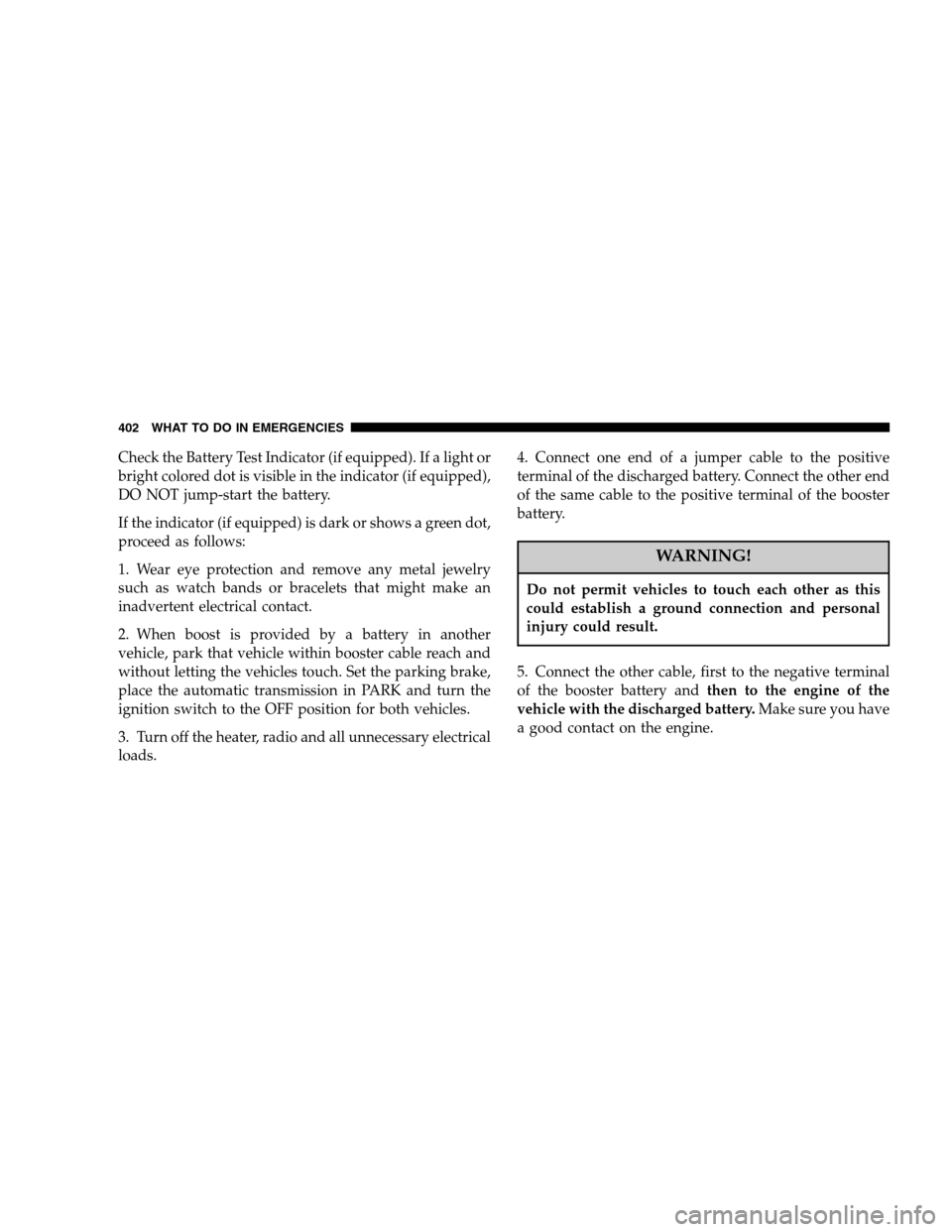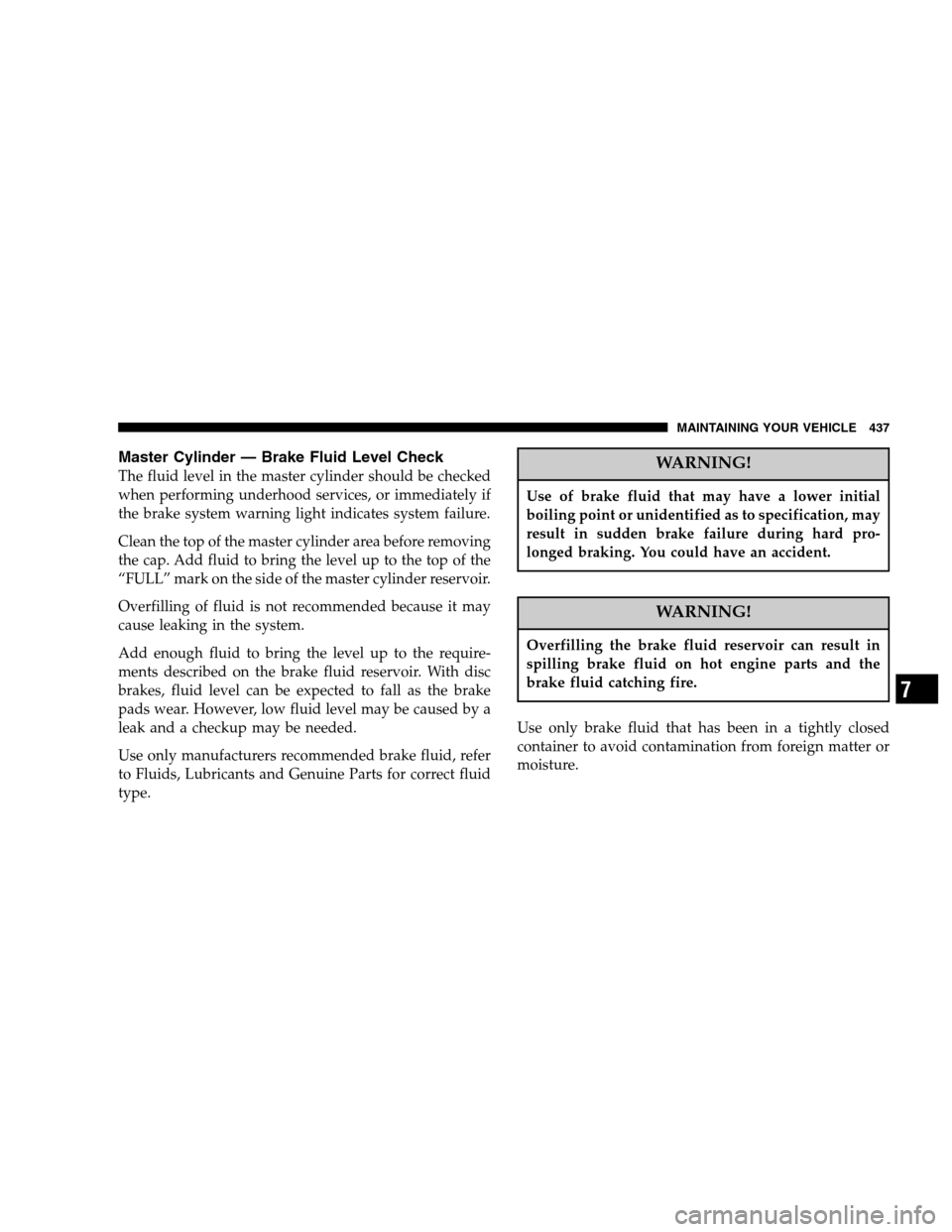Page 376 of 504

Towing Tips — Automatic Transmission
The “D” range can be selected when towing. However, if
frequent shifting occurs while in this range, the “3” range
should be selected.
NOTE:Using the “3” range while operating the vehicle
under heavy operating conditions will improve perfor-
mance and extend transmission life by reducing exces-
sive shifting and heat build up. This action will also
provide better engine braking.
The automatic transmission fluid and filter should be
changed if you REGULARLY tow a trailer for more than
45 minutes of continuous operation. See Schedule “B” in
section 8 of this manual for transmission fluid change
intervals.
NOTE:Check the automatic transmission fluid level
before towing.
Towing Tips — Electronic Speed Control (If
Equipped)
�
Don’t use in hilly terrain or with heavy loads.
�When using the speed control, if you experience speed
drops greater than 10 mph (16 km/h), disengage until
you can get back to cruising speed.
�Use speed control in flat terrain and with light loads to
maximize fuel efficiency.
Towing Tips — Cooling System
To reduce potential for engine and transmission over-
heating, take the following actions:
�City Driving
When stopped for short periods of time, put transmission
in neutral but do not increase engine idle speed.
376 STARTING AND OPERATING
Page 402 of 504

Check the Battery Test Indicator (if equipped). If a light or
bright colored dot is visible in the indicator (if equipped),
DO NOT jump-start the battery.
If the indicator (if equipped) is dark or shows a green dot,
proceed as follows:
1. Wear eye protection and remove any metal jewelry
such as watch bands or bracelets that might make an
inadvertent electrical contact.
2. When boost is provided by a battery in another
vehicle, park that vehicle within booster cable reach and
without letting the vehicles touch. Set the parking brake,
place the automatic transmission in PARK and turn the
ignition switch to the OFF position for both vehicles.
3. Turn off the heater, radio and all unnecessary electrical
loads.4. Connect one end of a jumper cable to the positive
terminal of the discharged battery. Connect the other end
of the same cable to the positive terminal of the booster
battery.
WARNING!
Do not permit vehicles to touch each other as this
could establish a ground connection and personal
injury could result.
5. Connect the other cable, first to the negative terminal
of the booster battery andthen to the engine of the
vehicle with the discharged battery.Make sure you have
a good contact on the engine.
402 WHAT TO DO IN EMERGENCIES
Page 412 of 504

cap until a�clicking�sound is heard. This is an indication
that the gas cap is properly tightened. Press the odometer
reset button to turn the message off. If the problem
persists, the message will appear the next time the
vehicle is started. This might indicate a damaged cap. If
the problem is detected twice in a row, the system will
turn on the Malfunction Indicator Light (MIL). Resolving
the problem will turn the MIL light off.
EMISSIONS INSPECTION AND MAINTENANCE
PROGRAMS
In some localities, it may be a legal requirement to pass
an inspection of your vehicle’s emissions control system.
Failure to pass could prevent vehicle registration.
For states, which have an I/M (Inspection and
Maintenance) requirement, this check verifies the
following: the MIL (Malfunction Indicator Lamp)is functioning and is not on when the engine is running,
and that the OBD (On Board Diagnostic) system is ready
for testing.
Normally, the OBD system will be ready. The OBD
system maynotbe ready if your vehicle was recently
serviced, if you recently had a dead battery, or a battery
replacement. If the OBD system should be determined
not ready for the I/M test, your vehicle may fail the test.
Your vehicle has a simple ignition key actuated test,
which you can use prior to going to the test station. To
check if your vehicle’s OBD system is ready, you must do
the following:
1. Insert your ignition key into the ignition switch.
2. Turn the ignition to the ON position, but do not crank
or start the engine.
3. If you crank or start the engine, you will have to start
this test over.
412 MAINTAINING YOUR VEHICLE
Page 427 of 504
Windshield and Rear Window Washers
The fluid reservoir for the windshield washers and the
rear window washer is shared. It is located in the engine
compartment and should be checked for fluid level at
regular intervals. Fill the reservoir with windshield
washer solvent (not radiator antifreeze) and operate the
system for a few seconds to flush out the residual water.
The washer fluid reservoir will hold a full gallon of fluid
when the Low Washer Fluid Light illuminates.
Washer Fluid Bottle
MAINTAINING YOUR VEHICLE 427
7
Page 437 of 504

Master Cylinder — Brake Fluid Level Check
The fluid level in the master cylinder should be checked
when performing underhood services, or immediately if
the brake system warning light indicates system failure.
Clean the top of the master cylinder area before removing
the cap. Add fluid to bring the level up to the top of the
“FULL” mark on the side of the master cylinder reservoir.
Overfilling of fluid is not recommended because it may
cause leaking in the system.
Add enough fluid to bring the level up to the require-
ments described on the brake fluid reservoir. With disc
brakes, fluid level can be expected to fall as the brake
pads wear. However, low fluid level may be caused by a
leak and a checkup may be needed.
Use only manufacturers recommended brake fluid, refer
to Fluids, Lubricants and Genuine Parts for correct fluid
type.WARNING!
Use of brake fluid that may have a lower initial
boiling point or unidentified as to specification, may
result in sudden brake failure during hard pro-
longed braking. You could have an accident.
WARNING!
Overfilling the brake fluid reservoir can result in
spilling brake fluid on hot engine parts and the
brake fluid catching fire.
Use only brake fluid that has been in a tightly closed
container to avoid contamination from foreign matter or
moisture.
MAINTAINING YOUR VEHICLE 437
7
Page 462 of 504
Once a Month
•Check tire pressure and look for unusual wear or
damage.
•Inspect the battery and clean and tighten the terminals
as required.
•Check the fluid levels of coolant reservoir, brake
master cylinder, power steering and transmission and
add as needed.
•Check all lights and all other electrical items for correct
operation.At Each Oil Change
•Change the engine oil filter.
•Inspect the exhaust system.
•Inspect the brake hoses.
•Inspect the CV joints and front suspension compo-
nents.
•Check the automatic transmission fluid level.
•Check the coolant level, hoses, and clamps.
462 MAINTENANCE SCHEDULES
8
M
A
I
N
T
E
N
A
N
C
E
S
C
H
E
D
U
L
E
S
Page 488 of 504

Oil (Engine).......................... 417
Radiator (Coolant Pressure)............... 432
Car Washes............................ 442
Carbon Monoxide Warning................. 352
Cargo Compartment
Luggage Carrier....................... 197
Cargo (Vehicle Loading)................... 197
Cassette Tape and Player Maintenance......... 274
Cassette Tape Player..................... 221
Catalytic Converter...................... 419
Caution, Exhaust Gas................. 42,87,352
CD (Compact Disc) Changer.......230,237,253,257
CD (Compact Disc)
Player............227,231,235,241,244,249,251,257
CD (Compact Disc) Player Maintenance........ 275
Cellular Phone........................ 98,272
Center High Mounted Stop Light............ 456
Center Lap Belts......................... 52
Chains, Tire............................ 341Changing A Flat Tire..................... 382
Chart, Tire Sizing........................ 325
Check Engine Light (Malfunction Indicator
Light) .............................217,412
Child Restraint........................ 73,75
Child Restraint Tether Anchors............... 78
Child Safety Locks........................ 37
Child Seat............................ 73,80
Clean Air Gasoline....................... 350
Cleaning
Wheels............................. 444
Climate Control......................... 276
Clock .............................219,256
Coat Hook............................ 196
Compact Disc (CD) Maintenance............. 275
Compact Disc (CD) Player...............221,227
Compact Spare Tire...................... 336
Compass.............................. 167
Compass Calibration..................... 168
488 INDEX
Page 490 of 504

Door Ajar Light......................... 212
Door Locks............................. 27
Door Locks, Automatic.................... 28
Door Opener, Garage..................... 175
DriveBelts ............................ 418
Drive Shaft Universal Joints................ 425
Driving
On Slippery Surfaces.................... 322
DVD Player (Video Entertainment System)...... 257
E-85 Fuel............................. 356
Electric Remote Mirrors.................... 96
Electrical Power Outlets................... 183
Electronic Speed Control (Cruise Control)...... 163
Electronic Vehicle Information Center (EVIC).... 171
Emergency, In Case of
Hazard Warning Flasher................. 380
Jacking........................382,383,394
Jump Starting......................... 401Overheating.......................... 381
Emission Control System Maintenance......412,460
Engine............................... 410
Air Cleaner Filter...................... 419
Block Heater......................... 310
Break-In Recommendations................ 86
Checking Oil Level..................... 414
Compartment......................... 410
Coolant (Antifreeze).................... 458
Cooling ............................. 429
Exhaust Gas Caution.................. 42,352
Flooded, Starting...................... 309
Fuel Requirements..................349,457
Oil ...........................414,457,458
Oil Change Interval.................... 416
Oil Disposal.......................... 418
Oil Filler Cap......................... 417
Oil Filter Disposal...................... 418
Oil Selection.......................417,457
490 INDEX